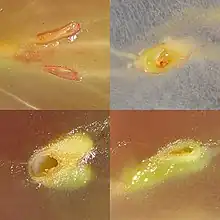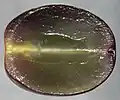Stenospermocarpy
Stenospermocarpy is the biological mechanism that produces parthenocarpy (seedlessness) in some fruits, notably many table grapes.

In stenospermocarpic fruits, normal pollination and fertilization are still required to ensure that the fruit 'sets', i.e. continues to develop on the plant; however subsequent abortion of the embryo that began growing following fertilization leads to a near seedless condition. The remains of the undeveloped seed are visible in the fruit.[1]
Most commercial seedless grapes are sprayed with gibberellin to increase the size of the fruit and also to make the fruit clusters less tightly packed. A new cultivar, 'Melissa', has naturally larger fruit so does not require gibberellin sprays.[2]
Grape breeders have developed some new seedless grape cultivars by using the embryo rescue technique.[3] Before the tiny embryo aborts, it is removed from the developing fruit and grown in tissue culture until it is large enough to survive on its own. Embryo rescue allows the crossing of two seedless grape cultivars.
There are two types of seedlessness in grapes: true seedlessness of parthenocarpic berries when only ovules may develop and commercial seedlessness of stenospermocarpic berries when aborted seeds go unnoticed when chewing.[4] Stenospermocarpic seeds vary significant in size and in the degree of development of the seed coat and the endosperm.[5] Larger seeds of stenospermocarpic grapes are referred to as rudimentary seeds and smaller ones as seed traces. A scientific article with many photos of ovules, aborted and normal seeds of the parthenocarpic, stenospermocarpic and seeded cultivars. [6]
Seedless grape cultivars
Seedless grapes are divided into white, red and black types based roughly on fruit color. The most popular seedless grape is known in the United States as 'Thompson Seedless', but was originally known as 'Sultana'. It is believed to be of ancient origin. It is considered a white grape, but is actually a pale green. Other white cultivars are 'Perlette', 'Menindee Seedless', 'Interlaken', 'Himrod', 'Romulanus', 'Lakemont', 'Fayez', and 'Remaily Seedless.' The most popular red seedless in the U.S. is 'Flame Seedless'. Other red cultivars are 'Crimson Seedless', 'Ruby Seedless', 'Suffolk Red', 'Saturn' and 'Pink Reliance'. Some black cultivars are 'Black Beauty', 'Black Monukka', 'Concord Seedless', 'Glenora' and 'Thomcord.'
 Thompson Seedless
Thompson Seedless Sheegene 21
Sheegene 21 Crimson Seedless
Crimson Seedless IFG Three
IFG Three A red seedless
A red seedless IFG Seventeen
IFG Seventeen
See also
References
- Soule, J. (1985), Glossary for Horticultural Crops, New York: Wiley, ISBN 978-0-471-88499-6, cited in Huang, Jing-Hao; Ma, Wei-Hong; Liang, Guo-Lu; Zhang, Ling-Yuan; Wang, Wei-Xing; Cai, Zi-Jian; Wen, Shou-Xing (2010), "Effects of low temperatures on sexual reproduction of 'Tainong 1' mango (Mangifera indica)", Scientia Horticulturae, 126 (2): 109–119, doi:10.1016/j.scienta.2010.06.017
- Ramming, D.W. 1999. New grape trio. Agricultural Research 47(10): 23.
- Wood, M. 1997. Mouth-watering new fruits Agricultural Research 45(8): 9-10.
- Stout, A. 1936. Seedlessness in grapes New York State Agricultural Experiment Station Technical Bulletin 238: 68.
- Striem, M.J., Spiegel-Roy, P., Baron, I., Sahar, N. 1992. The degrees of development of the seed-coat and the endosperm as separate subtraits of stenospermocarpic seedlessness in grapes Vitis: Journal of Grapevine Research 31(3): 7.
- Costantini, L., Moreno-Sanz, P., Nwafor, C.C. et al. 2021. Somatic variants for seed and fruit set in grapevine BMC Plant Biology 21(135): 33.